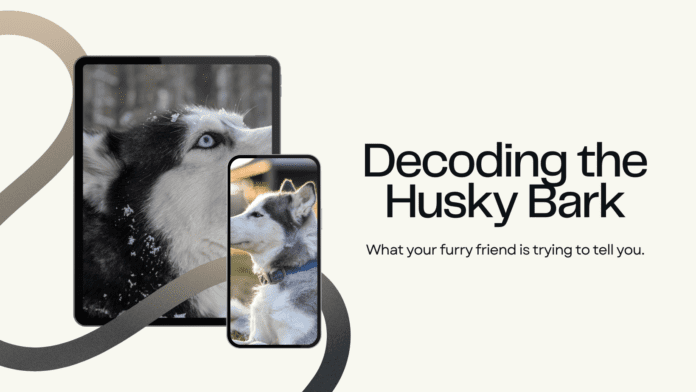Last Updated on January 13, 2024 by Dogs Vets
The Husky Bark Decoded: From Woo-Woos to Howls, We Tell You What He’s Saying!
Ever stared at your Siberian Husky, mid-woo-woo extravaganza, wondering what in the frozen tundra that charming furball is trying to tell you?
Huskies, those majestic sled-pulling goofballs with piercing blue eyes and vocal cords that make opera singers jealous, are notorious for their unique brand of vocalization.
It’s not just barking, friends; it’s a symphony of howls, yodels, and those infectious, soul-stirring woo-woos that could melt a glacier.
But amidst the delightful cacophony, a question burns: what the heck is your Husky saying?

Fear not, fellow Husky adventurers! Today, we’re cracking the Husky bark code. We’ll dissect the howls, decipher the yodels, and translate those woo-woos into plain English (well, sort of).
By the end of this epic journey, you’ll be a Husky whisperer, fluent in the language of the North.
So grab a cup of cocoa, cuddle up with your furry friend, and let’s dive into the fascinating world of Husky vocalizations!
Understanding Husky Communication
Before we embark on our decoding mission, let’s set the stage. Unlike your average Labrador retriever, whose barks are a straightforward “Squirrel alert!”, Huskies are a breed steeped in ancient history and primal instincts.
Their communication evolved for survival in the harsh Siberian landscape, where howling across vast distances was crucial for pack cohesion and hunting.
This means their vocalizations are often nuanced, with a complex blend of emotions and intentions woven into each bark, howl, and woo-woo.
The Husky Vocal Repertoire
Now, let’s get down to the nitty-gritty. What are the different types of Husky vocalizations, and what might they mean?
• The Bark:
The classic bark, of course, makes an appearance. But even here, there’s variety. A sharp, high-pitched bark could indicate excitement or alarm.
A deeper, sustained bark might signal frustration or territoriality. And then there’s the playful bark, a rapid-fire series of short barks punctuated by happy tail wags, that’s basically your Husky saying, “Let’s play fetch, you giant hairball dispenser!”
• The Howl:
The quintessential Husky sound, the howl, is a primal expression. It can be used for long-distance communication, pack bonding, or simply because your Husky feels like serenading the moon. A lonely howl might be a call for your attention, while a joyful group howl could signal playtime or the anticipation of a yummy adventure.
• The Woo-Woo:
Ah, the woo-woo, the crown jewel of the Husky vocal repertoire. This infectious yodel-like sound is pure Husky magic. It can express excitement, happiness, even a touch of sass.
Imagine your Husky greeting you at the door with a flurry of excited woo-woos, tail wagging like a metronome set to “turbo fluff.” That’s pure Husky joy, right there.
Decoding the Husky Message
Okay, so we’ve explored the Husky vocal toolbox.
Now, how do we actually decipher their messages?
Remember, context is key. Consider the situation, your Husky’s body language, and the specific type of vocalization.
A high-pitched bark while staring out the window likely means “Squirrel!”, while a sustained howl at sunset might be your Husky communing with their wolfy ancestors.
Here are some additional tips
- Pay attention to body language: A wagging tail usually indicates a positive emotion, while flattened ears or bared teeth suggest caution.
- Consider the context: Is your Husky excited, bored, frustrated? The environment and situation can offer clues.
- Listen to the tone: A sharp bark is different from a playful bark, and a mournful howl is distinct from an excited one.
- Don’t be afraid to experiment: Talk to your Husky, use calming tones, and offer positive reinforcement when they communicate appropriately.
Building a Husky-Human Bond
Understanding your Husky’s vocalizations is just the first step to building a strong bond.
By learning their language, you can anticipate their needs, address their concerns, and deepen your connection.
Remember, communication is a two-way street. Talk to your Husky, use playful commands, and shower them with affection when they “speak” to you.
The more you listen, the more you’ll understand, and the closer you’ll become.
So, there you have it, folks! We’ve demystified the Husky bark, decoded the yodels, and translated the woo-woos into human speak.
Now, go forth and listen to your Husky friends. You might just be surprised at what they have to say!
But don’t be fooled by your newfound fluency in Husky-ese. Mastering this furry dialect takes dedication and a healthy dose of patience.
Huskies, bless their fluffy socks, are not known for their linguistic consistency.
Just when you think you’ve cracked the code, they’ll throw in a head-scratching yodel-bark-woo-woo combo that leaves you feeling like a lost tourist in Siberia.
Remember, Huskies live in their own unique realm of communication.
Their vocalizations are often a blend of instinct, emotion, and, let’s be honest, sheer vocal joy. Don’t get bogged down by trying to pinpoint the exact meaning of every bark or howl.
Instead, embrace the symphony of sounds, the playful nuances, and the sheer exuberance woven into their vocal tapestry.
Think of it like learning a new language with a single, enthusiastic teacher who loves talking but isn’t particularly concerned with proper grammar.
You’ll have your fair share of head-scratching moments, but the journey will be filled with laughter, tail wags, and enough woo-woos to melt the iciest of hearts.
Here are some ways to embrace the linguistic adventure
- Record your Husky’s vocalizations: This can help you identify patterns and subtle variations in their communication.
- Play detective: Pay attention to what triggers specific vocalizations. Does your Husky howl at sirens? Yodel when you grab the leash? Woo-woo at the sight of squirrels?
- Learn from other Husky owners: Share your experiences and insights with fellow Husky enthusiasts. You’d be surprised how much you can learn from a pack of fur-covered language experts.
Ultimately, understanding your Husky’s vocalizations is about building a deeper connection.
It’s about learning to listen not just with your ears, but with your heart.
It’s about embracing the playful chaos, the soulful howls, and the infectious woo-woos that make Huskies the most charmingly vocal creatures on four legs.
So, the next time your Husky unleashes a vocal avalanche, don’t reach for the earplugs.
Grab a cup of cocoa, cuddle closer, and open your heart to the symphony of Husky-ness.
You might just discover a language far more expressive, far more joyful, than any human tongue could ever speak.
And now, onto some burning questions you might have about your Husky’s vocal repertoire:
FAQs:
Why does my Husky howl at sirens?
Huskies, with their strong pack instincts, might mistake sirens for other dogs or wolves howling in the distance. It’s their way of joining the pack chorus, even if it’s a siren chorus.
Should I be worried if my Husky barks excessively?
Excessive barking can be a sign of boredom, anxiety, or separation distress. Make sure your Husky gets plenty of exercise, mental stimulation, and quality time with you to address these potential issues.
Can I train my Husky to stop barking?
Positive reinforcement training is key. Reward your Husky when they communicate calmly and redirect their attention with engaging activities when they start barking excessively.
Is it true that female Huskies are more vocal than males?
There’s no definitive scientific evidence to support this, but some Husky owners anecdotally report that their female Huskies tend to vocalize more.
Do Huskies understand what we’re saying to them?
Huskies, like most dogs, understand basic commands and the tone of your voice. They might not grasp the nuances of human language, but they certainly pick up on our emotions and intentions.
Remember, the journey to understanding your Husky’s vocalizations is an ongoing adventure.
Embrace the chaos, celebrate the woo-woos, and enjoy the heartwarming symphony of your Husky’s unique language.
With patience, love, and a healthy dose of laughter, you’ll unlock a deeper connection with your furry friend that transcends the limitations of human speech.
Now go forth and woo-woo with confidence!
Verified Source References:
- American Kennel Club: https://www.akc.org/dog-breeds/siberian-husky/
- Siberian Husky Club of America: https://www.shca.org/
- VCA Animal Hospitals: https://vcahospitals.com/know-your-pet/dog-breeds/siberian-husky
- The Spruce Pets: https://m.youtube.com/watch?v=fa0ogUfelAI

















